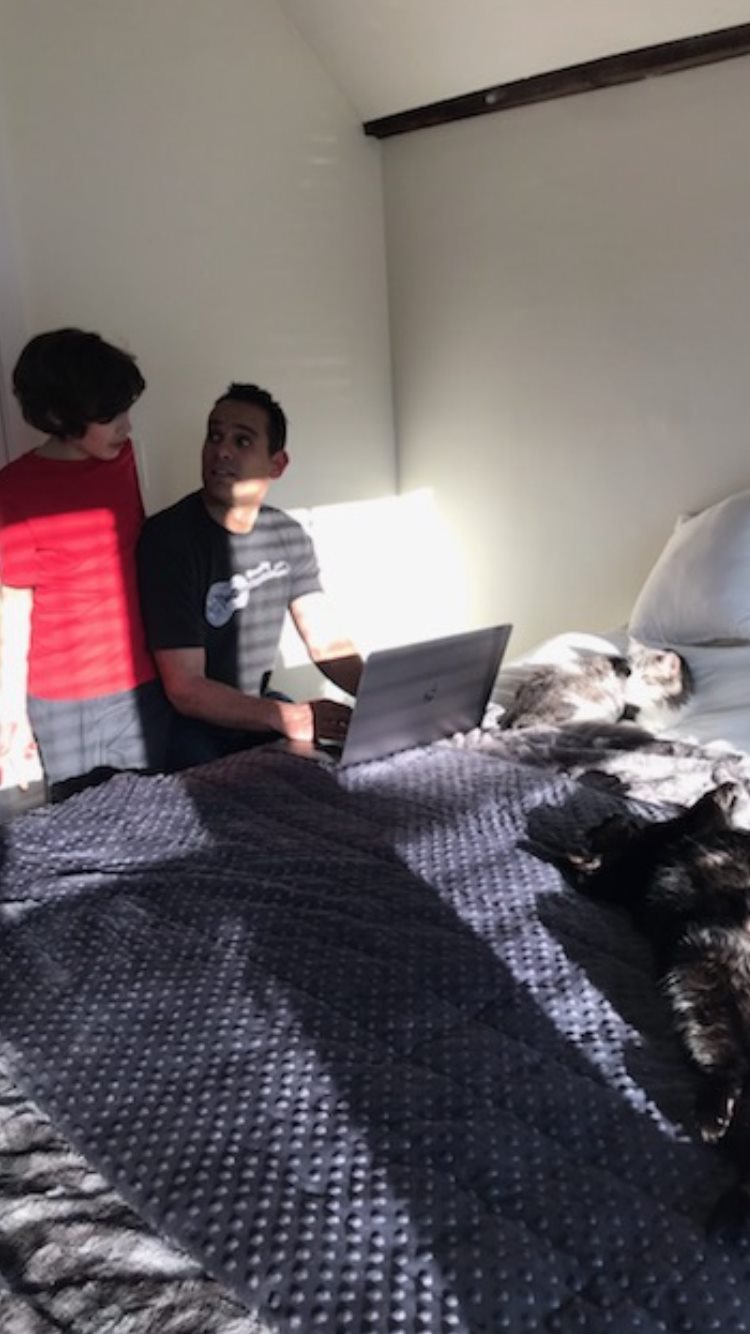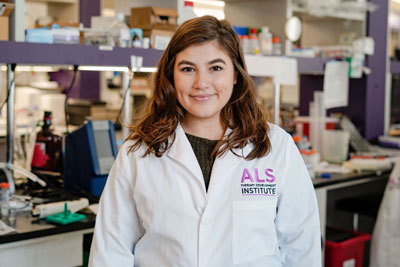 These days, Dr. Fernando Vieira gets to sleep in until 5:30am. It’s an hour later than his morning alarm would have awakened him two months ago, before the COVID-19 pandemic forced the ALS Therapy Development Institute (ALS TDI), like many organizations across the world, to adapt to a new reality of social distancing and remote work. There are few silver linings to be found in this situation, but not having to commute does afford him an extra hour of sleep, before he begins his day working as the leader of ALS TDI’s diverse team of scientists and researchers.
These days, Dr. Fernando Vieira gets to sleep in until 5:30am. It’s an hour later than his morning alarm would have awakened him two months ago, before the COVID-19 pandemic forced the ALS Therapy Development Institute (ALS TDI), like many organizations across the world, to adapt to a new reality of social distancing and remote work. There are few silver linings to be found in this situation, but not having to commute does afford him an extra hour of sleep, before he begins his day working as the leader of ALS TDI’s diverse team of scientists and researchers.
Dr. Vieira’s home has an open floor plan with lofted rooms, so he needs to be quiet as he goes down the stairs each morning – his son Locke, a fourth-grader, will certainly still be asleep. Quietly as he can, he puts out food for his two cats and scoops their box and then unloads the dishwasher. He puts on a pot of coffee and prepares a quick breakfast while listening to the New York Times podcast to catch up on the day’s news. Then it’s time to fix Locke’s breakfast, usually corn flakes and fruit, with occasional treats such as pancakes or breakfast sausage.
By 7:00amhe’s through his first cup of coffee, and it’s time for a shower. That’s when the first thoughts of the work day begin to enter his mind. Heading to his “office” (AKA his bedroom), he gets dressed, makes the bed, and prepares to finally begin his day, the majority of which will now be spent communicating on phone calls and zoom meetings, coordinating the activities of ALS TDI’s research team.
“The biggest difference working from home is losing the ability to communicate quickly and seamlessly across our multidisciplinary teams by walking down the hall,” he says. “That’s a major advantage of having all areas of our science happening under one roof. Collaborating remotely, while possible, is just not as effective or efficient.”
By 8:00am, he’s on the phone. The first call of the day is often to Dr. Steve Perrin, ALS TDI’s CEO. Their discussions range from the latest data on COVID-19 and the logistics of how and when we will begin to safely ramp up lab operations, to the latest experimental results in ALS research, to potential grant applications to fund our continued research.
“It is helpful and comforting to exchange ideas and share perspectives with someone who knows so many of the same details about our circumstances,” says Dr. Vieira.
After hanging up with Dr. Perrin, the next several hours are usually spent catching up with the various members of the science team. This could be a check-in with Dr. Theo Hatzipetros about the projects being carried out by the pharmacology team, or Dr. Matvey Lukashev about the status of the translational team’s work. He might call Nancy Poole and/or Alan Premasiri about the ongoing operations of the Precision Medicine Program, whose hundreds of participants continue to supply us with invaluable data from home. Often, he touches base with the group of scientists still going into the lab to work on essential projects, such as Val Tassinari, who works to maintain our new zebrafish facility, or Kaly Mueller, who carries out experiments in animal models with CMAP technology.
Beyond technical issues, these conversations sometimes take a more personal tone.
“COVID19 has introduced a lot of uncertainty about safety, health, and well-being of our team and our families,” he says. “Furthermore, there are a lot of questions about the types of lab work that can be completed in the near-term. The pandemic has also had a massive economic impact - notably in the non-profit world. We are all facing a lot of uncertainty. Roles on the science team have adapted to continue our research amidst the new circumstances. Good communication is important in uncertain times.”
At 11:30am, it’s time for a break. Dr. Vieira comes down from the bedroom office to fix lunch for himself and Locke, who has been working hard at his remote schoolwork supervised by his mom, Brigitte. While he’s away from the phone and the zoom screen, Fernando tries to be helpful as well, working through classroom concepts with Locke.
By 12:15pm, he’s back to work. The early afternoon usually brings another slew of meetings, this time beginning with the non-research staff of ALS TDI. He might speak with someone from the communications or development teams about how to communicate the work that we are doing to end ALS and the need for funding to support our various research projects. He’ll also often schedule calls with our outside collaborators, including academic ALS researchers, other biotech and pharmaceutical scientists, and technology companies such as Google.
At 2:30pm, after calls and zooms, Dr. Vieira often finds its time for some fresh air. He heads out for a twenty minute walk with Locke, maybe they’ll play catch for a bit, to get his blood flowing and to prepare to finish the day strong.
After the walk, the workday finally turns to business other than meetings. With ALS TDI’s science team still conducting many ongoing experiments, there is plenty of data to go through and review. He will also often work to conceive new experiments to move ongoing projects forward. ALS TDI often tries to share results from these and past experiments with the larger scientific community – to this end, Dr. Vieira might work on scientific papers for peer-reviewed journals. In order to keep this research funded – an important consideration in these uncertain economic times – he might spend some time writing grant applications.
“Drafting grant proposals can be productive even if the proposals are not funded,” he says. “The process can steward a clear organization of thoughts and help to compel generation of new ideas. It’s also a massive amount of work!”
Around 5:00pm, the workday is done. He heads back downstairs to unwind by preparing dinner.
“I enjoy this process,” he adds. “It relaxes me. I like feeding people.”
At 6:00pm, he often tries to connect with the ALS TDI team, and the wider ALS community, in a more relaxed context. Like so many other people across the world, our social lives mostly take place through Zoom these days, but the team has kept in touch by organizing digital happy hours, crossword puzzle sessions, and video game nights to maintain our sense of camaraderie.
“I’ve been heartened by the leadership that so many staff members have shown by keeping people connected through remote versions of activities that have always brought us together,” he says. “It’s great that we’ve expanded a lot of these evening social activities to include the entire ALS community through things like Trivia Nights.”
At 7:00pm, he excuses himself from the online hangout for TV with the family. Right now they’re working their way through the Marvel movie series. At 8:30pm, it’s time for one last run through his emails to address any urgent last-minute issues and prepare himself for the coming work day.
By 9:00pm, the day is starting to wind down. Dr. Vieira puts Locke to bed and reads him a story. Right now, they’re working their way through Harry Potter and the Sorcerer’s Stone. Then it’s time to rest up for an early morning, and to do it all again the next day, the next day, and the next, until it’s safe to go back to the lab.
To learn more about how ALS TDI is continuing research amid the COVID-19 pandemic, click here.